Ditto¶



Ditto is a framework which allows you to do transformations to an Airflow DAG, to convert it into another DAG which is flow-isomorphic with the original DAG. i.e. it will orchestrate a flow of operators which yields the same results, but was just transformed to run in another environment or platform. The framework was built to transform EMR DAGs to run on Azure HDInsight, but you can extend the rich API for any other kind of transformation. In fact you can transform DAGs such that the result is not isomorphic too if you want (although at that point you’re better off writing a whole new DAG).
The purpose of the framework is to allow you to maintain one codebase and be able to run your airflow DAGs on different execution environments (e.g. on different clouds, or even different container frameworks - spark on YARN vs kubernetes). It is not meant for a one-time transformation, but for continuous and parallel DAG deployments, although you can use it for that purpose too.
At the heart, Ditto is a graph manipulation library, with extendable APIs for the actual transformation logic. It does come with out of the box support for EMR to HDInsight transformation though.
Installation¶
pip install airflow-ditto
A quick example¶
Ditto is created for conveniently transforming a large number of DAGs which follow a similar pattern quickly. Here’s how easy it is to use Ditto:
ditto = ditto.AirflowDagTransformer(DAG(
dag_id='transformed_dag',
default_args=DEFAULT_ARGS
), transformer_resolvers=[
AncestralClassTransformerResolver(
{
EmrCreateJobFlowOperator: EmrCreateJobFlowOperatorTransformer,
EmrJobFlowSensor: EmrJobFlowSensorTransformer,
EmrAddStepsOperator: EmrAddStepsOperatorTransformer,
EmrStepSensor: EmrStepSensorTransformer,
EmrTerminateJobFlowOperator: EmrTerminateJobFlowOperatorTransformer,
S3KeySensor: S3KeySensorBlobOperatorTransformer
}
)], transformer_defaults=TransformerDefaultsConf({
EmrCreateJobFlowOperatorTransformer: TransformerDefaults(
default_operator= hdi_create_cluster_op
)}))
ditto.transform(emr_dag)
or just…
hdi_dag = ditto.templates.EmrHdiDagTransformerTemplate(DAG(
dag_id='transformed_dag',
default_args=DEFAULT_ARGS
), transformer_defaults=TransformerDefaultsConf({
EmrCreateJobFlowOperatorTransformer: TransformerDefaults(
default_operator=hdi_create_cluster_op
)})).transform(emr_dag)
You can put the above call in any python file which is visible to airflow and the resultant dag loads up thanks to how airflow’s dagbag finds DAGs.
Source DAG (airflow view)

Transformed DAG

A more complex example¶
This is how you can transform any EMR operator based DAG to an HDInsight operator based DAG (using operators from the airflow-hdinsight project):
ditto = ditto.AirflowDagTransformer(DAG(
dag_id='HDI_dag',
default_args=DEFAULT_DAG_ARGS,
dagrun_timeout=timedelta(hours=2),
max_active_runs=1,
schedule_interval=None,
),
transformer_resolvers=[
AncestralClassTransformerResolver({
EmrCreateJobFlowOperator: EmrCreateJobFlowOperatorTransformer,
EmrJobFlowSensor: EmrJobFlowSensorTransformer,
EmrAddStepsOperator: EmrAddStepsOperatorTransformer,
EmrStepSensor: EmrStepSensorTransformer,
EmrTerminateJobFlowOperator: EmrTerminateJobFlowOperatorTransformer,
S3KeySensor: S3KeySensorBlobOperatorTransformer
})],
transformer_defaults=TransformerDefaultsConf({
EmrCreateJobFlowOperatorTransformer: TransformerDefaults(
default_operator=create_cluster_op
),
CheckClusterSubDagTransformer: TransformerDefaults(
default_operator=create_cluster_op)}),
subdag_transformers=[CheckClusterSubDagTransformer],
debug_mode=True)
new_dag = ditto.transform(original_dag)
There’s a lot happening here, but the above example uses (almost) all capabilities of the Ditto API. It finds source operators using a resolver which specifies it’s transformers, it takes default operators, transforms operators and replaces them with new sub-DAG of operators, uses a SubDagTransformer to transform and replaces entire sub-DAG of operators, where the sub-DAGs to be found are found using matchers and so on. The above DAG transformation logic is provided out of the box as a template: EmrHdiDagTransformerTemplate
Source DAG (rendered by ditto)
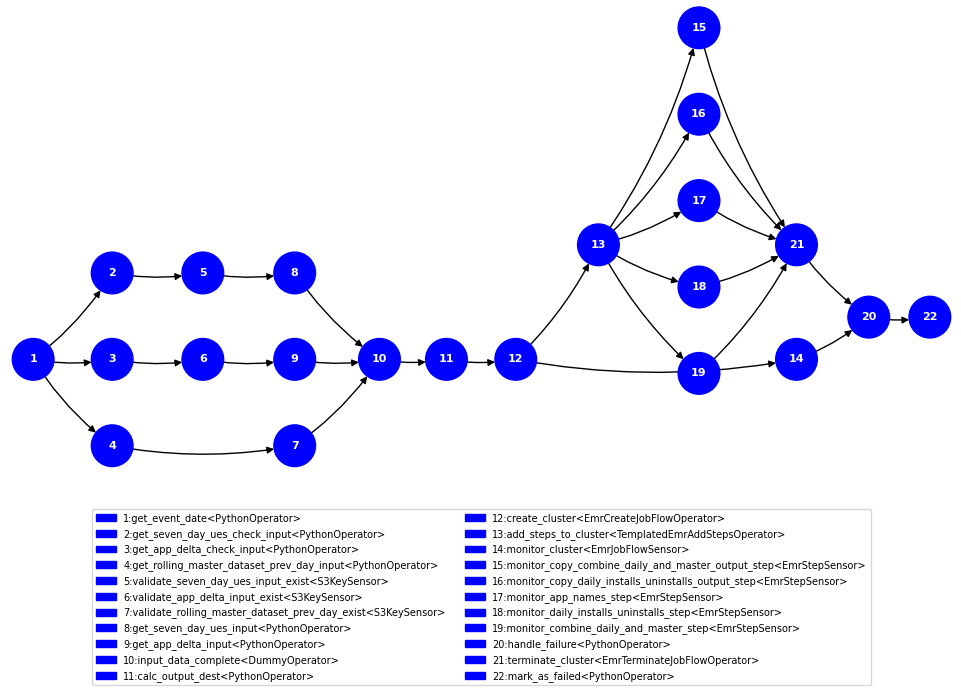
Transformed DAG
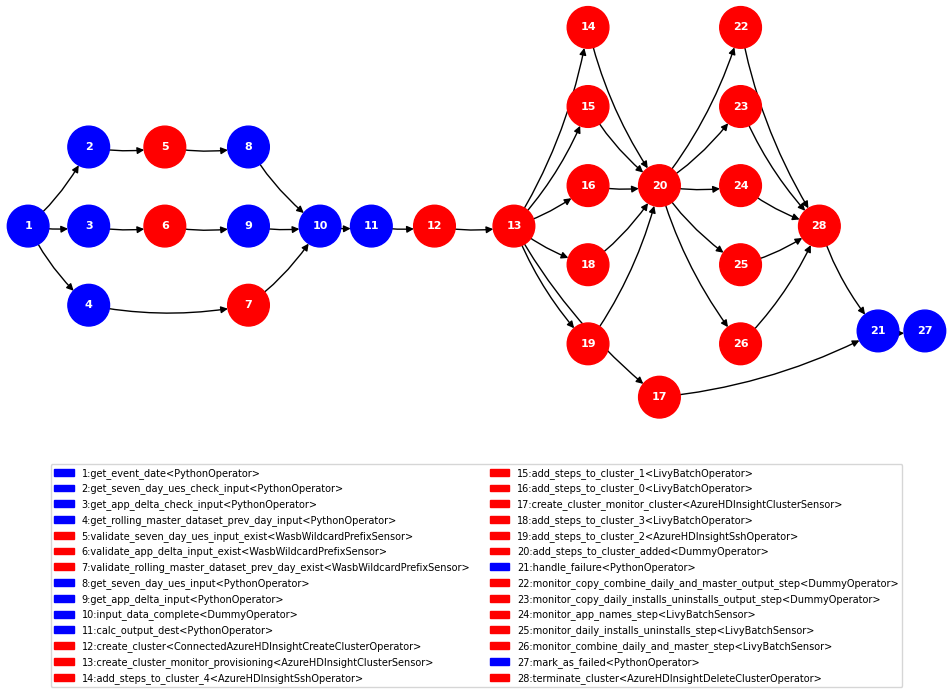
Concepts¶
Transformers¶
At the bottom of the abstraction hierarchy of Ditto’s API are Transformers. These are the basic nuts and bolts of the system. These are called from Ditto’s core during a transformation to convert the source DAG’s operators to the target DAG’s operators. There are two types of Transformers: OperatorTransformer and SubDagTransformer. We’ll talk about the former first, as the latter requires munching up a few more concepts to understand. An example OperatorTransformer could look like this:
class IAmABasicTransformer(OperatorTransformer):
def transform(self, src_operator: BaseOperator, parent_fragment: DAGFragment,
upstream_fragments: List[DAGFragment]) -> DAGFragment:
op = LivyBatchSensor(
batch_id="foo",
task_id=src_operator.task_id,
azure_conn_id="foo",
cluster_name="foo",
verify_in="yarn",
dag=self.dag
)
return DAGFragment([op])
As you can see, it can access the src_operator, choose to copy its fields or do whatever it pleases with it in order to create the target operator. Transformers return DAGFragments, which represents an intermediate sub-DAG of the target DAG you’re trying to create. DAGFragments can contain one or an entire sub-DAG of operators, and are linked to each other in a graph structure.
Here’s an example of an OperatorTransformer which returns a transformed sub-DAG:
class IAmASlightlyMoreComplexTransformer(OperatorTransformer):
def transform(self, src_operator: BaseOperator, parent_fragment: DAGFragment,
upstream_fragments: List[DAGFragment]) -> DAGFragment:
tp1 = LivyBatchSensor(
batch_id="foo",
task_id = "t2p1",
azure_conn_id="foo",
cluster_name=src_operator.dest_bucket_key,
verify_in="yarn",
dag=self.dag
)
tp2 = DummyOperator(task_id='t2p2', dag=self.dag)
tp3 = DummyOperator(task_id='t2p3', dag=self.dag)
tp4 = DummyOperator(task_id='t2p4', dag=self.dag)
tp5 = PythonOperator(task_id='t2p5', python_callable=print, dag=self.dag)
tp1 >> [tp2, tp3] >> tp4
return DAGFragment([tp1, tp5])
As you can see this returns an entire sub-DAG instead of just one target operator. This DAGFragment will replace the src_operator, at its position in the source DAG, in the target DAG returned by Ditto.
About parent_fragment and upstream_fragments
Transformers sometimes need access to transformations of previous upstream transformers. E.g. you created the cluster, but now the add-steps operator needs to know the cluster name or ID, or your step-sensor needs to know the job ID from add-steps. parent_fragment is the DAGFragments of the parent op in the source DAG. You can traverse it using find_op_in_fragment_list() or a whole bunch of other utility methods to find a matching parent previously transformed. Similarly, upstream_fragments contains all the upstream transformed tasks. Think of it as a level-order/BFS traversal, uptil this task, in the target DAG transformed so far.
This is a core part of how Ditto works: it allows transformers to talk to each other while tranforming a DAG. Look at the EmrStepSensorTransformer or EmrAddStepsOperatorTransformer to see how this works.
Resolvers¶
Ok, so you made a bunch of cool transformers. But how would Ditto know which one to use for which source operator? That’s where Resolvers come in. As you can see in the examples given at the beginning, when you initialize ditto’s core (AirflowDagTransformer), you give it a bunch of resolvers to use. When traversing the source graph, it asks each resolvers to resolve a transformer for that source task. It then uses that Transformer to transform that source task. Ditto provides the following Resolvers out of the box, but you can write your own:
ClassTransformerResolver: find transformer based on source task’s python classAncestralClassTransformerResolver: find transformer based on all the ancestor classes of the source task’s python classPythonCallTransformerResolver: match a transformer with an operator if its aairflow.operators.python_operator.PythonOperatorand it’spython_callableis calling a specified python method inside. It uses runtime source code parsing to achieve this. This comes handy when you want to transform customPythonOperatorsorBranchPythonOperatorsin the source DAG and match on them.
SubDag Transformers and Matchers¶
This is where Ditto gets serious, if it did not appear so already. Suppose you want to transform entire sub-DAGs of the source DAG and replace them with your own subgraph of operators, and not just match on individual tasks. This is where SubDagTransformers come in. This is best explained with an example
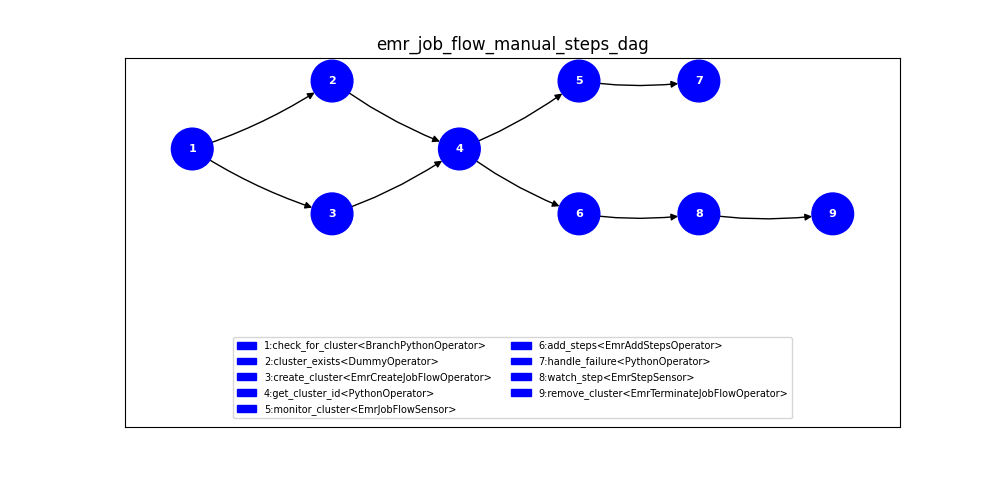
In this DAG, there’s a pattern we want to match and replace:
check_for_emr_cluster_op >> [create_cluster_op, cluster_exists_op]
create_cluster_op >> get_cluster_id_op
cluster_exists_op >> get_cluster_id_op
The DAG first checks if an EMR cluster exists, creates one if it doesn’t and then with getting the cluster ID for downstream tasks. If we wanted to convert this to an HDInsight DAG, we wouldn’t need this shebang, because AzureHDInsightCreateClusterOperator is idempotent, in that it simply does all of the above inside the operator itself (not explicitly, due to the nature of the HDInsight management API simply ignoring the create call if the cluster already exists). So we can cook up the following SubDagTransformer to solve this problem:
class CheckClusterSubDagTransformer(SubDagTransformer):
def get_sub_dag_matcher(self) -> List[TaskMatcher]:
check_for_emr_cluster_op = PythonCallTaskMatcher(check_for_existing_emr_cluster)
create_cluster_op = ClassTaskMatcher(EmrCreateJobFlowOperator)
cluster_exists_op = ClassTaskMatcher(DummyOperator)
get_cluster_id_op = PythonCallTaskMatcher(xcom_pull)
check_for_emr_cluster_op >> [create_cluster_op, cluster_exists_op]
create_cluster_op >> get_cluster_id_op
cluster_exists_op >> get_cluster_id_op
return [check_for_emr_cluster_op]
def transform(self, subdag: nx.DiGraph, parent_fragment: DAGFragment) -> DAGFragment:
transformer = EmrCreateJobFlowOperatorTransformer(self.dag, self.defaults)
return transformer.transform(
TransformerUtils.find_matching_tasks(
subdag, ClassTaskMatcher(EmrCreateJobFlowOperator))[0], parent_fragment)
The resulting DAG looks like this:
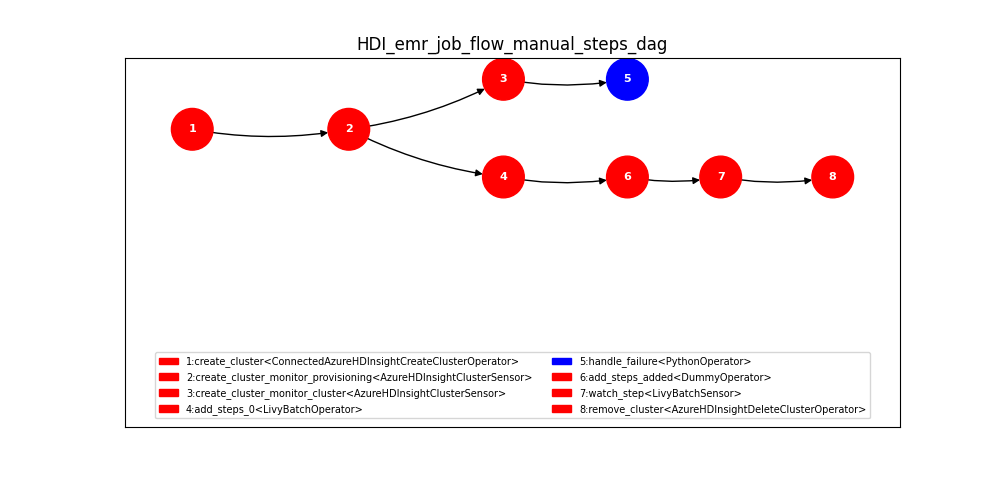
This is very powerful. You can provide multiple SubDagTransformers to Ditto, each one of them can find a sub-DAG and replace it with their own DAGFragments. The API allows you to declaratively and easily conjure up a TaskMatcher DAG which the transformer will find. TaskMatcher or just Matchers are similar to Resolvers, in that you use them to match on the signature of the operator someway (class-based, python-call-based, or what have you), but they can be expressed as a DAG of matchers using the same bitshift assignment you are used to with airflow tasks. Then, behind the scenes, Ditto solves the subgraph isomorphism problem, which is an NP-complete problem, of finding a sub-DAG inside another DAG (using the matchers as the node equivalence functions!). It uses python networkx library to do this (with some jugglery to map airflow DAGs and matcher DAGs to networkx graphs and so on). See find_sub_dag() for more details.
Here’s a more complex example, where the matching sub-DAG is [Matcher(op2,op6), Matcher(op3,op7)] >> Matcher(op4,op8)and the resultant sub-DAG has 5 nodes.
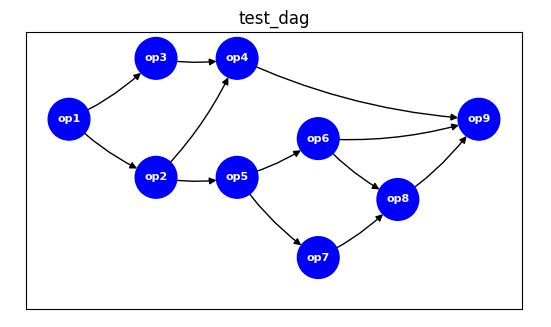
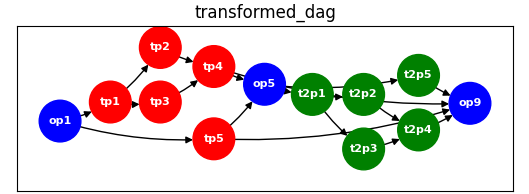
Templates¶
Templates are nothing but a configuration of OperatorTransformers, Resolvers, SubDagTransformers and their Matchers stitched together with some defaults. You can then reuse templates to transform several DAGs at different places. Templates bring it all together for you to use Ditto conveniently.
API Documentation¶
Built-in implementations¶
Here are some of the built-in implementations of Ditto’s API constructs available out of the box. You can find documentation of how each of them behave and work inside their python docstrings themselves.